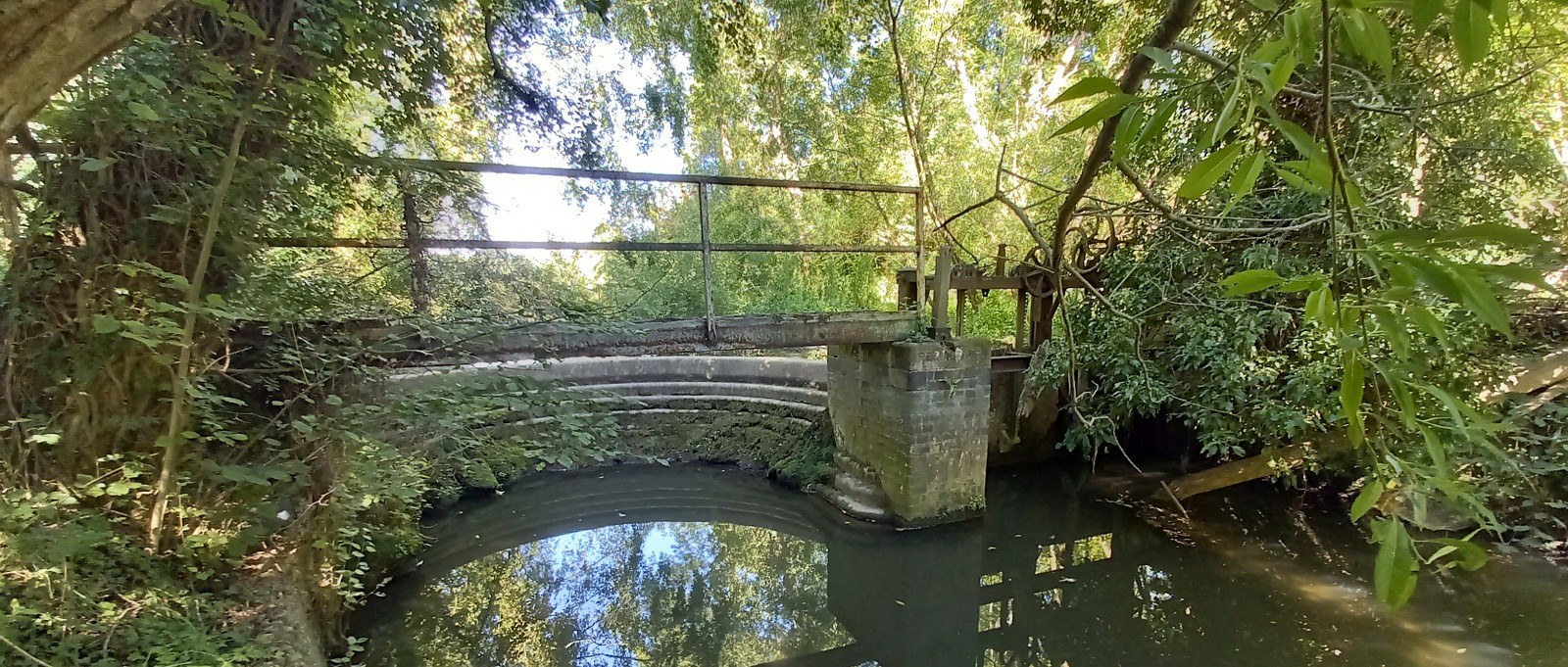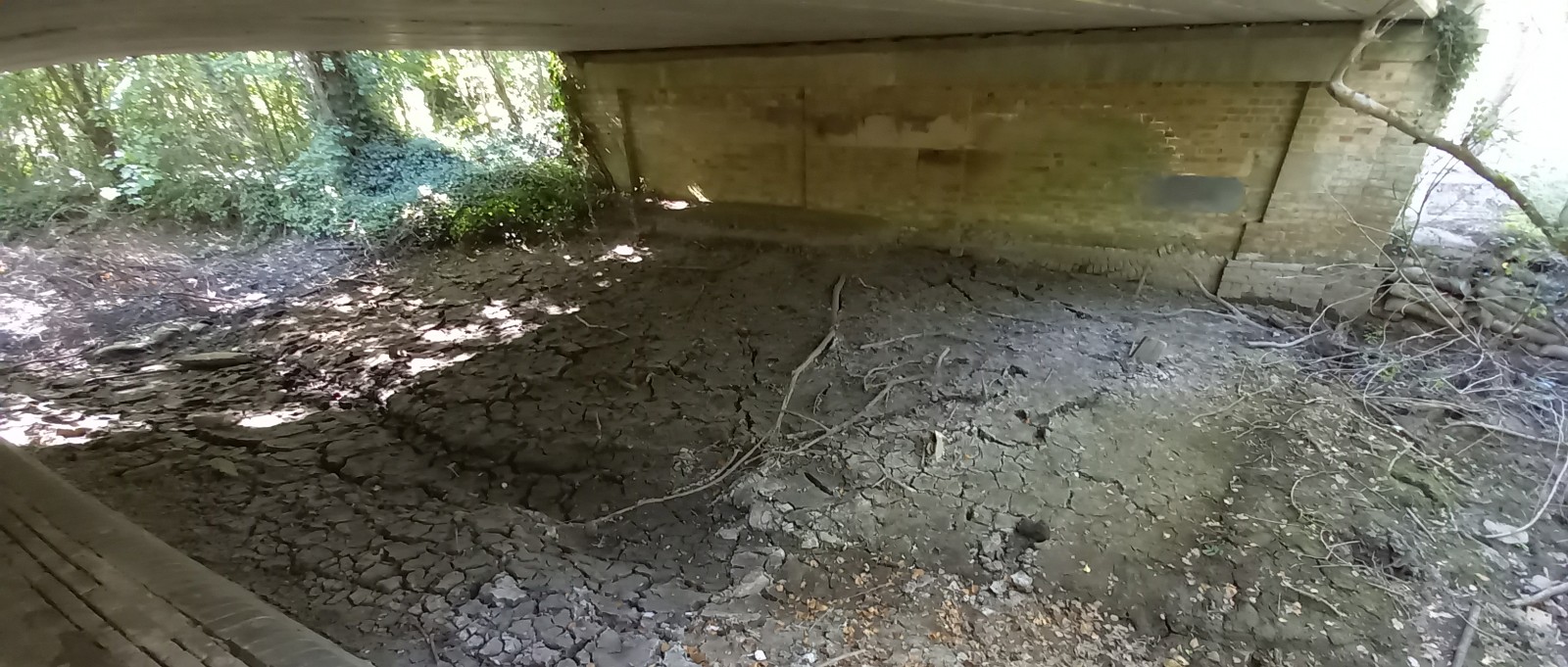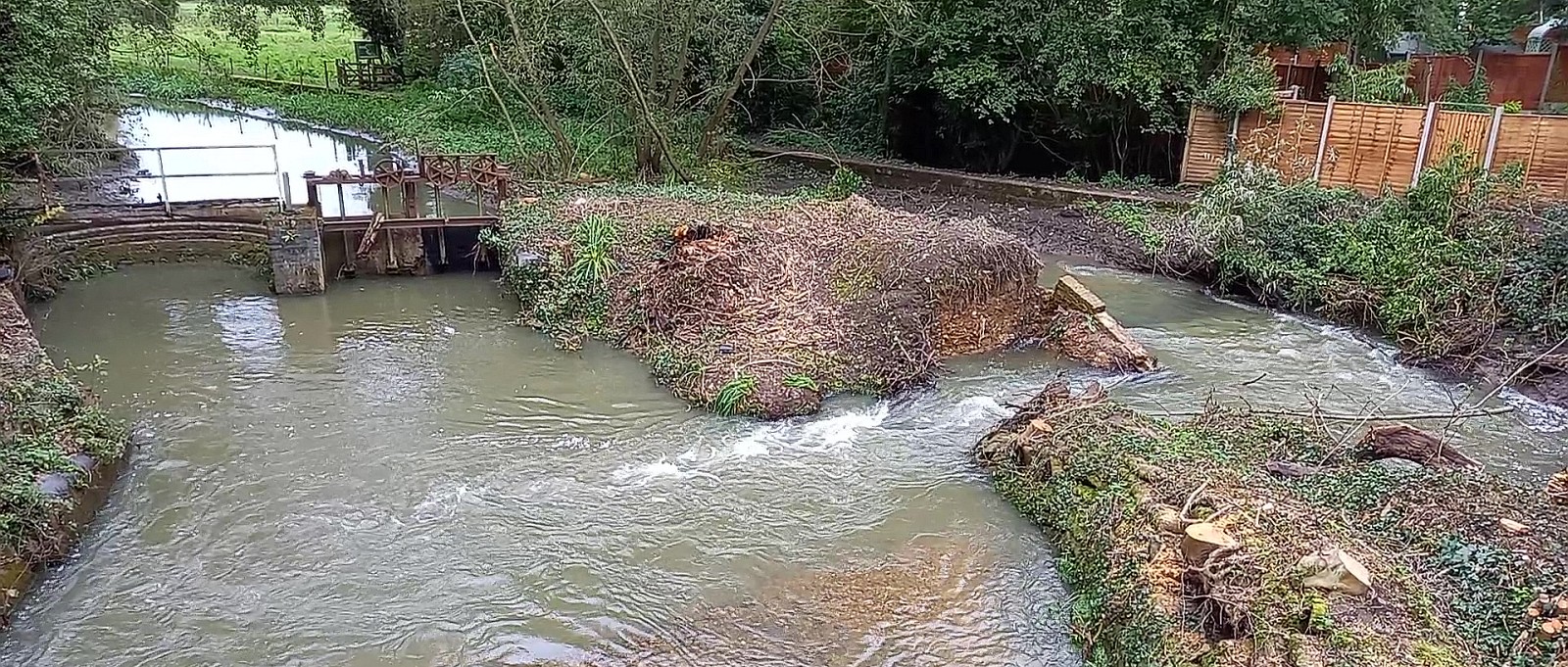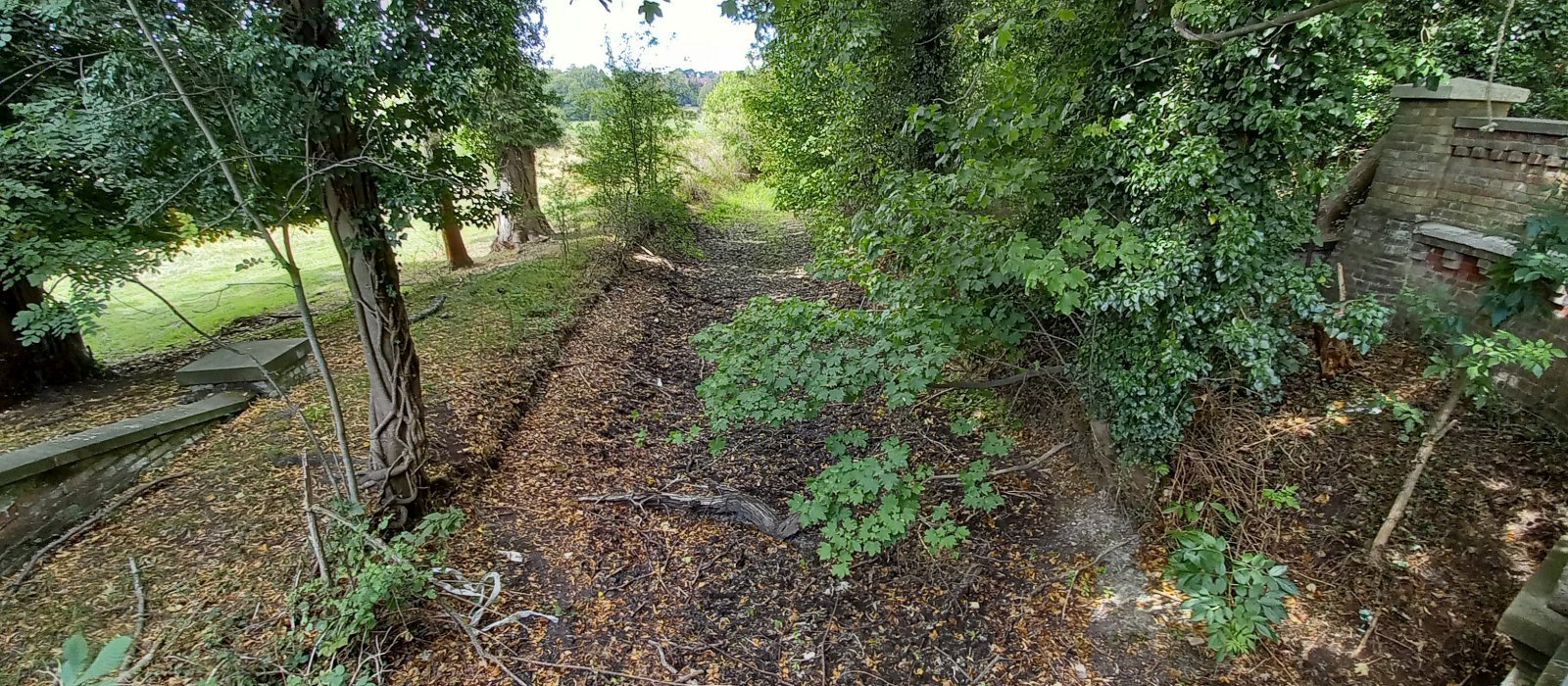What is Molewood Mill Race
The Molewood Mill Race is an ancient 760m watercourse that runs from the southern end of Waterford Marshes to the site of the former Molewood Mill, west of Bengeo.
The corn mill operated until 1888 when it was bought by Hertford Corporation and demolished to establish a pumping station for the town's water supply.
A weir and sluice gates are located at the southern end of Waterford Marsh, which regulates the amount of water continuing down the river. At this point the unobstructed mill race splits off from the river.
The river is controlled by the Environment Agency. The ownership of the land where the river and mill race part is uncertain.
 Weir and sluice gates
Weir and sluice gates
The Breach
In September 2019 a large tree fell across the bank separating the river from the mill race, close to the weir. This caused a breach in the bank, diverting water from the mill race back into the River Beane. As a result, water stopped flowing into the race and the channel dried up over its entire length.
Campaign
In May 2020 a campaign was established to try and restore the flow of water back in to the mill race. A Facebook page was set up and at the time of writing has 425 members.
Introducing themselves, the campaign say:
The Molewood Millrace forms an important part of our local ecosystem. It supports a wide range of wildlife and acts as an extra flood water defence for the local area.
It has been part of the local environment for hundreds of years and removing it will cause irretrievable damage.
The millrace has dried up and needs to be restored to save the thousands of fish that are now at risk, as well the many other animals (swans, kingfishers, ducks, coots, heron) who are struggling to cope with the new environment.
The issue is an immediate one with fish now dying every day and, as worrying, subsidence now impacting local structures.
We need your help, so please join us and help us take action to save this important local waterway.
Informal representations were made to the Environment Agency, as well as local councillors and other stakeholders.
After a detailed assessment of the impact of the breach by The Campaign, a formal letter was sent to the Environment Agency, countersigned by District and County Councillors, directly impacted local businesses and landowners, Beane Marshes Conservation Group, Hertford Civic Society, Stapleford Parish Council, Molewood Residents Association and the Society for the Protection of Ancient Buildings (Mills Division).
 The dried up mill race as it passes under North Road
The dried up mill race as it passes under North Road
Fallen Trees
At the beginning of August, two trees fell next to the mill race where it passes under a railway bridge, requiring attention from Network Rail contractors. There have been suggestions that the drying out of the mill race may have contributed to the trees falling. Other trees have also fallen where the flow of the River Beane has declined
Environment Agency Response
Initially there was very little response from The Environment Agency. There was a suggestion that the EA would not regard the breach as an issue because it restored the natural flow of the river (before the weir was installed) and the ecosystem may even benefit.
Following the formal letter from The Campaign, The Environment Agency issued the following statement at the end of July:
The River Beane is an internationally rare chalk stream habitat which has undergone decades of degradation due to historic weirs which have caused slow flows, sedimentation and blockages to fish passage.
The collapse of part of an embankment on the River Beane at Waterford Marsh just outside Hertford, has meant that a significant stretch of the River Beane is now able to flow again, as it would have done naturally. The weir structure and adjacent channel embankment separating the River Beane from the Molewood Millrace which is in poor condition has breached, meaning that the weir at the bottom of Waterford Marsh, which impounded the river and created poor river habitat upstream, has been bypassed.
Owing to the increased flow rate and shallower water, the river is now moving over cleaner gravels that are essential for our rare chalk rivers, providing perfect fish spawning habitat. In addition, the recovery will mean new vegetated channel and banks will be able to establish, providing better habitat for rare and threatened insects and mammals. The failure of this structure has not led to an increase in flood risk to properties within the area.
We recognise that as a consequence of the breach there has been a drop in water levels in some areas of Waterford Marsh, including the loss of flow to the Molewood Mill Race, which provides habitat for wildlife and is a locally valued and attractive feature. It is therefore our intention to explore how best to support these habitats and whether there is a feasible option to return some flow to the mill race whilst ensuring that the River Beane receives the flows it need to thrive as a chalk river.
The Environment Agency and the Hertfordshire County Council’s Countryside Management Service are working together to explore options to further enhance the chalk stream habitat through the area, as well as protecting the riverside Public Right of Way. This includes stabilising the bank at the breach location, to make permanent the benefits to the river. We will also be discussing options with the relevant landowners whose permissions will be needed.
The Environment Agency has prioritised some funding for the project and as a first step will clear some of the fallen trees and debris from the channel so that the extent of the breach can be better assessed.
We will be engaging with local stakeholders to ensure that the best solution is found for the River Beane, the wider environment and local people.
Within days, engineers started clearing the land around the breach, removing trees and vegetation and revealing the full extent of the breach. This had the effect of further increasing the flow of water through the breach, leading to a fall in the level of the river upstream.
 The breach after clearance
The breach after clearance
In October 2020, some thirteen months after the initial breach, The Environment Agency issued a further update.
The River Beane is an internationally rare chalk stream habitat which has undergone decades of degradation due to historic weirs which have caused slow flows, sedimentation and blockages to fish passage.
The collapse of part of an embankment at Waterford Marsh just outside Hertford, has meant that a significant stretch of the River Beane is now able to flow again, as it would have done naturally. The weir structure and adjacent channel embankment separating the River Beane from the Molewood Millrace which was in poor condition has breached. This means that the weir at the bottom of Waterford Marsh, which impounded the river and created poor river habitat upstream, has been bypassed.
The river is now moving over cleaner gravels due to the increased flow rate and shallower water. The gravels provide a perfect fish spawning habitat and are essential for chalk rivers. New vegetation will now be able to establish in the channel and on the banks providing a better habitat for rare and threatened insects and mammals.
The breach has resulted in a drop in water levels in some areas of Waterford Marsh, including the loss of flow to the Molewood Mill Race, which provides habitat for wildlife and is a locally valued and attractive feature. We will explore how we can support these habitats and whether there is a feasible option to return some flow to the mill race whilst ensuring that the River Beane receives the flows it need to thrive as a chalk river.
Together with Hertfordshire County Council’s Countryside and Rights of Way Service we are exploring options to further enhance the chalk stream habitat through the area, as well as protecting the riverside Public Right of Way. This includes stabilising the bank at the breach location, to make permanent the benefits to the river. We will also be discussing options with the relevant landowners whose permissions will be needed.
We have prioritised some funding for the project and have cleared some of the fallen trees and debris from the channel so that we can better assess the extent of the breach. In September, we also removed some trees from the central island where the breach has occurred to prevent them falling onto the footpath and / or into the channel. We are currently awaiting results from modelling to inform the options appraisal for the site.
We have been and will continue to engage with local stakeholders to ensure that the best solution is found for the River Beane, the wider environment and local people.
Latest Statement From The Campaign
At the end of October the Restore Molewood Mill Race campaign said: "The Beane and Millrace are 'main rivers' so are under EA control - any work needs to be done by them, or with their consent. In August, two officers from their biodiversity team visited the area and met with us. Ideologically their preference is to remove weirs and to maximize water flow down the river at the expense of the millrace. We hope to find an engineering compromise that restores some flow to the millrace. Currently the EA are assessing whether there's any impact on flood-risk, as this determines their legal liability and the funds available - this analysis has been delayed but we expect an answer in the next few weeks.
This article was last updated on 30th October 2020.
